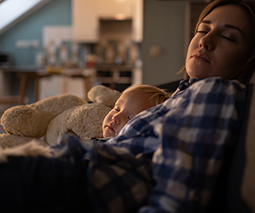Secretly co-sleeping with your baby? You’re not the only one

A new study spearheaded by Susan Stewart, a professor of sociology at Iowa State University, discovered that 50 percent of parents studied were keeping their co-sleeping habits a secret from friends, family, and even their child’s paediatrician.
Musical beds
Susan’s compiled the results of her research in a new book, Co-Sleeping: Parents, Children, and Musical Beds. She said that despite pressure to avoid co-sleeping, families were adopting the practice for the sake of (at least a little bit of) sleep.
Susan’s definition of co-sleeping is broad and allowed for a wide range of parenting styles and situations.
In Susan’s study, co-sleeping is defined as “one or both parents sometimes or regularly sleeping with their children in the same bed or room at night or part of the night.”
Frowned upon
While they may be snuggling up together regularly, families are often keeping it on the down-low, acutely aware that others may frown on the practice, for various reasons.
“Everybody thinks they know how to parent better than everybody else,” Susan said. “Unfortunately, there’s a lot of judgement and, in general, very little support for parents.”
Tired mums and dads are intentionally or unintentionally dozing off with their little people. Susan explained that co-sleeping is sometimes the easiest option for worn-out families.
“Parents are exhausted, they’re stressed and honestly, it’s often easier to co-sleep,” Susan said.
“There’s no one size fits all, and in my view; there is no right or wrong.”
Discouraged
This idea of “no right and wrong” may confuse some parents.
Luckily the good folk at Australian SIDS prevention organisation, Red Nose offer some important clarification on the styles of co-sleeping that are safest, as the language around co-sleeping can create confusion about the best ways to keep babies safe.
Red Nose explains:
“There is much debate in the literature about the practice of, and definitions for, bed-sharing and co-sleeping. For the purpose of this statement the term ‘sharing a sleep surface’ is used to include bed-sharing and co-sleeping practices. Bed-sharing refers to bringing the baby onto a sleep surface where co-sleeping is possible, whether intended or not. Co-sleeping is defined as a mother and/or her partner (or any other person) being asleep on the same sleep surface as the baby.”
Red Nose, keeps it simple, telling us that:
- Sharing a sleep surface – a definition that the term “co-sleeping” often refers to – can be risky for babies.
- Sharing a room with a baby, however is encouraged by the experts at Red Nose.
“The safest place to sleep a baby is in their own safe sleeping place in the same room as an adult care-giver,” Red Nose explains.
Red Nose warns parents that sleeping on the same bed, couch, mattress or other sleep surface as their baby is not advised.
“Sharing a sleep surface with a baby can increase the risk of sudden unexpected death in infancy (SUDI). A considerable proportion of SUDI occur on a shared sleeping surface,” they say.
Sleep school
Many parents are accidentally or intentionally sharing a sleep-surface with their child, in the name of a better night’s sleep, exhaustion and/or more snuggles with their child.
The fact that they’re not talking about it openly is telling.
It’s important to be aware of the safety guidelines surrounding this practice – and to do your own research and make an informed choice if you’re co-sleeping with your kiddo.
And remember, good folk like the gang at Red Nose are in the business of saving little lives. Why wouldn’t we listen to their wise words?!
 Need some more baby sleep advice? Our Parent School sleep experts can help. Click to find out more or book a one-on-one session.
Need some more baby sleep advice? Our Parent School sleep experts can help. Click to find out more or book a one-on-one session.









